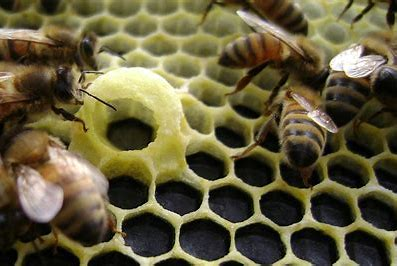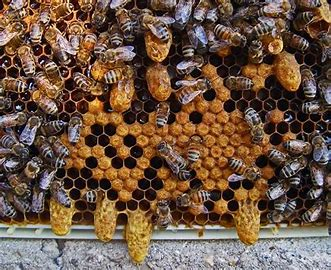I complete comprehensive hive checks 10 days. If you miss a hive check your colony is in danger of swarming and if your queen has gone missing and you don't catch this early enough, your female worker bees will develop ovaries due to the absence of the queen's pheromones. The result is laying workers who lay strictly unfertilized eggs. This destroys honeycomb because all the cells become drone comb. A clear indication you have laying workers is multiple eggs in a single cell.

Remember, it is the size of the wax cell that determines whether a queen will lay a fertilized egg or an unfertilized egg. Fertilized eggs become female workers, and the females should make up 90% of the colony population.

In the photo above, the flat pupa cells in the middle are female worker cells. The convex cells that protrude more on either side of the worker cells are drone cells. These will become male bees who don't have stingers which means they can't protect the hive and they don't forage because they can't fly as far as female worker bees and they don't have a long enough proboscis (tongue) to forage for nectar.
The only effective way I know of to remedy a laying worker problem is to lay a large white sheet on the ground at least 50 feet away from the hive and even better would be on the opposite side of a structure (house, shed, barn) from the hive. Then take one or two frames at a time and walk them over to the sheet. Shake all the bees off the frames onto the middle of the sheet. Then place the frames in a cooler or tote with a lid. Keep doing this until every frame has been shaken over the sheet. Once all frames are free of bees and in the secure storage box, put the frames back into the hive box(es). Believe it or not, the bees who have not yet developed ovaries and started laying unfertilized eggs will not allow the egg-laying workers back into the hive.
The best way to avoid this is to keep checking your bees every 10 days. Once you determine you definitely have a queen, by seeing her and/or evidence by cells with single eggs or larva laying at the back of many cells, you must remove all queen cells. This prevents swarming which causes your colony population to decrease by at least 50%.
Remember, one of your main goals is to help your colony increase population before the honeyflow, which occurs the entire month of July and beginning of August. Removing all queen cells is absolutely necessary and should be done meticulously!
It only takes 14 days for a fertilized egg, that is fed royal jelly for its entire metamorphosis, to become an adult queen. Here are some photos of queen cells preparing to hatch:
When completing hive checks, I start on one side of the hive box. Pulling frames out of the middle of the hive can increase chances of smashing the queen.
Pulling frames out of the hive slowly, I look closely into the back of the cells for eggs, larva, pollen and nectar stores. Here is what a healthy brood pattern should look like:
The white wax cells at the top is stored sugar water or honey. The open cells are mostly pollen stores. The pupa cells are usually in the shape of a large oval with a few open cells.
Below is a photo of a spotty queen. This is undesirable!
If I end up with a spotty queen, it means she was not well bred in the first three to five days of her life when she was fertile and completing mating flights. Perhaps the weather was not conducive to mating flights. I tend to put a spotty queen back into a small queen cage and hang it in the hive until I find a new queen to introduce. Once I find another queen, I remove the original, spotty queen and hang the new queen cage right smack dab in the middle of the hive between two frames, leaving the cap on. I don't want the new queen released too soon or the colony may kill her. I keep the new queen caged for minimum of five days before removing the cap so the bees can eat the fondant, slowly releasing the queen.
I am still feeding my colonies sugar water. They seem to be finding plenty of pollen now from willow, and now the birch trees. I won't give them any more pollen patties until I see rain forecasted for many days in a row. If they aren't able to forage due to rain or cold weather, some breeds of queens will slow down or completely stop laying eggs until the bees can bring in more resources again once the weather improves.
I will stop feeding sugar water when three or more frames are full of sugar water stores. It is super important for the queen to have space to lay eggs. If she doesn't have room to lay, she may leave the hive.
When I see plenty of dandelions, I remove my sugar feeder because these flowers are the first natural source of nectar.
I am reducing my entrances to the smallest setting at night and opening them up completely by removing the sticks in the morning on 40*45* mornings.
I think I'll be adding my second boxes under the first brood box next weekend, Sunday, May 21st.














